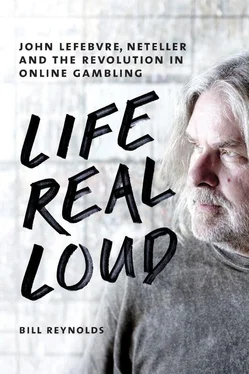Lawrence and Lefebvre had lined up approximately thirty business-to-business clients (i.e., bookies), each of them with anywhere from dozens to thousands of clients (i.e., gamblers). It’s tempting to wonder why Lawrence settled on Costa Rica. There were other legal jurisdictions — Antigua, for instance — but it didn’t have as large a customer base. And there were other, lesser centers, such as the aforementioned Dutch Antilles, or “ABCs,” north of Venezuela: Aruba, west and slightly north of Curaçao; Bonaire, due east of Curaçao; and Curaçao itself. Later, when online gambling became more popular — and more corporate — the Isle of Man became the preferred home for Neteller. At this point, though, that ancient farming island, located east and south of Belfast, north and west of Liverpool, and stuck in the middle of the Irish Sea for no particular reason except that it broke water during the Ordovician Period, around 450,000 million years ago, hadn’t yet come into view as a viable alternate. It hadn’t yet become the kind of experience where they would need to alert authorities ahead of time that they would be arriving at Isle of Man Ronaldsway Airport, seven miles southwest of Douglas, with marijuana. That was later. For now, it was enough to know that Costa Rica had always been one of the major centers for gambling.
* * *
By May 2000, Lawrence had the incorporation documents for Neteller and had struck a deal for the company to take possession of an oversized space above the Keg restaurant at Eleventh Avenue and Fifth Street SW, along the strip known as “Electric Avenue.” Aside from stealing the title of an Eddy Grant party song, Electric Avenue was known for being the place where boisterous Calgarians could get loaded with impunity. The cops were there, of course, on the lookout for some poor sucker to toss into the drunk tank, and there was the odd episode where hundreds of overserved locals created a ruckus on the street, but otherwise it was the usual strip of booze joints for the bourgeoisie.
The early days at the Keg building consisted of, first, Lawrence working alongside Lefebvre, and then Lawrence cruising by once in a while when he wasn’t looking after his development properties in Bridgeland, east of downtown, or in Midnapore, where Neteller was conceived. Otherwise, Lawrence left the operation in Lefebvre’s hands. They both worked at Neteller for nothing. Lefebvre had saved up a bit of cash, maybe five grand, from the various lawyer gigs offered to him by McMullen. He was living on $800 a month and selling enough pot to cover his habit. He could afford to commit himself to long hours on the phone with customers. “I had enough money,” he says. “I could work for nothing for a while.”
Up to August 2000, when Glavine arrived, Lefebvre mostly worked alone in a cavernous, three-thousand-square-foot space, one-third of which was dedicated to Neteller. Lawrence had an office and nothing else in that part; the rest was leased to his other businesses. Lefebvre worked seven days a week, from the opening of business in New York to closing time on the West Coast, 9 p.m. PST. He soon found that people tended to gamble at all hours, so he had better be there. On weekends, Neteller’s customer service department — that is, Lefebvre — worked later. Sometimes he was on the phone until midnight. Finally, he’d go downstairs to his purple RAV — he’d park out front early then run up and down pumping coins into the meter all day until parking was free again — climb in, drive to his condo, crash, get up at five and do it again. He spent most of his waking hours troubleshooting and getting accounts to work: “I can’t get my money to transfer”; “I can’t figure out how to get my money from my account to Neteller”; “my son stole my credit card and set up an account — I swear, it wasn’t me”; “can I have fifty bucks please? I’ll pay you back tomorrow.”
Eventually, Glavine, who would take over all IT responsibilities, and Bob Edmunds, who would be Mr. Mom in the morning and Mr. CFO in the afternoon, joined Lefebvre. A few months later, after multiple near-death experiences for the company, more people would get desks above the Keg. There would always be room for Hacky Sack.
* * *
On Thursday, August 24, 2000, Steve Glavine received a call on his Motorola flip-top cell phone. He was sitting in the Fusion Media Group parking lot with his buddy Doug Rigby. They had just left the office, where they both worked, and were are about to pull out onto Tenth Avenue SW. “Hey, I hear you’re the number-one ColdFusion guy in the city,” said the man on the line.
Glavine cracked up. “Doug!” he shouted to his friend. “You wouldn’t believe what this guy just said to me …”
Rigby had started up an internet design company the previous year and had invited Glavine to join. Glavine was glad to jump to Fusion Media. He wanted something (anything) to take him away from what he’d been doing for the past four years. After completing his degree in business administration at Acadia University, he’d abandoned Nova Scotia for Calgary in the spring of 1996. “There’s lots of work out west,” a friend had told him, “if you’re out here and interested.”
He promptly stranded himself. There was the dead-end job changing tires at an auto parts chain store. And then there was the lucrative-but-brain-numbing lure of working for a company called Midland, “spraying weeds and killing trees for TransAlta hydro underneath power lines.” After a few years of that, Glavine was in dire need of change: “At Midland you work every single day for four or five months. You make good money in overtime, but it’s a racket. You’d see guys working there ten, fifteen years, inhaling chemicals all day long. I just didn’t want to be one of those guys.”
Glavine’s work had him outside Calgary for months at a time. When he quit Midland for the second time, having replenished his savings again, he moved back to the city and looked up Rigby, with whom he’d previously shared a place. Because of his business degree at Acadia, Rigby started Glavine in sales at Fusion Media, which made perfect sense except for one thing — Glavine had always been fascinated with computers. He’d gotten a Commodore 64 in ninth grade and, just fiddling around, figured out things on computers many could not. He agreed to start in sales but made it known his real interest was in programming. Rigby suggested he give ColdFusion a whirl — it was one of the easier HTML programs to learn. Glavine bought a manual at a bookstore and checked it out. He picked it up quickly by playing around with a mock website he’d paid an Edmonton company to host for him.
Glavine says:
In front of the internet program you used, you have another server. The ColdFusion server has to process the page first before it sends it out to somebody’s browser. I hired this company in Edmonton called Fox Microsystems to host a test website so I could play with ColdFusion. I’d talk to Ron Billings up there about technical stuff or to restart the server. When the two Neteller programmers quit, Johnny called Ron because it just so happened that Neteller was hosting its ColdFusion website at Fox Micro. That’s where the connection was.
When Lefebvre flattered Glavine, telling him he’d heard he was the best, etc., Glavine knew it wasn’t true. But he took the pitch anyway. He said, sure, I know a few things about ColdFusion. They agreed to meet the next day, a Friday, at the offices above the Keg.
Glavine’s buddy Rigby eventually became part of the Neteller story, too. He assumed the mantle of head designer and splashed a gaudy orange Neteller logo on his first iteration of the company website. “If you go to WayBackMachine.com you can see the first one I designed in 2000,” says Glavine. “It was horrible compared to now. Well, it was horrible even for the day. And then we had a rendition that looked like PayPal’s. After that, Doug came on and designed the site until 2004 or ’05.”
Читать дальше












